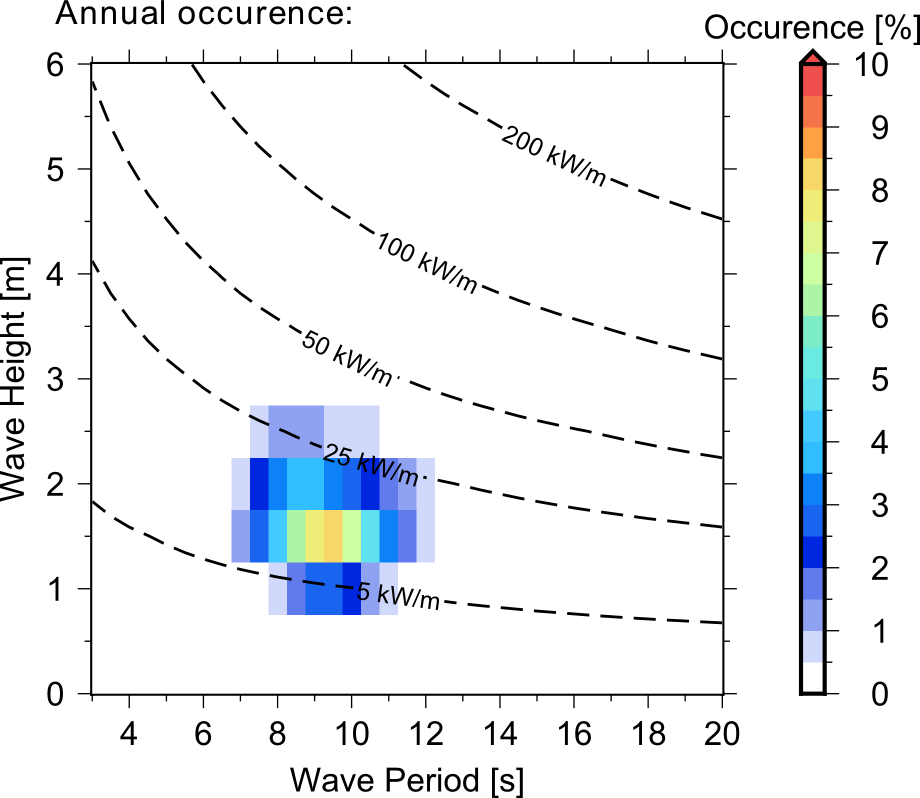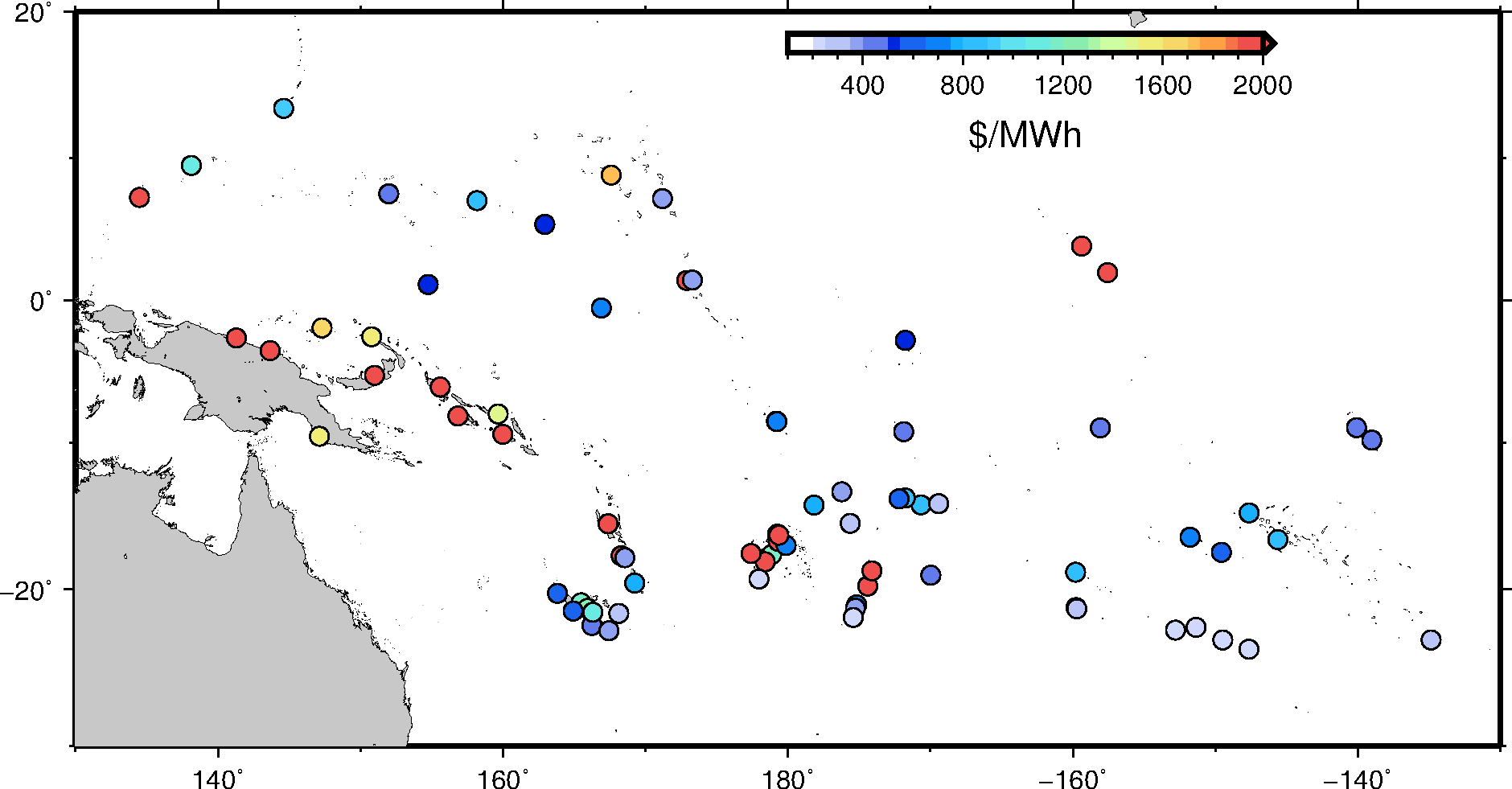Cost of Wave Energy
The cost of energy is a measure of generating electricity considering all lifetime costs and energy production. The cost of energy is measured by equating the power production with estimated costs which yields the cost of power in $/kWh. The cost of energy is variable dependant on the device, the cost of the installation, the maintenance cost and the amount of energy extracted. It does not take into account profits or subsidies and therefore doesn't always reflect to the price of energy that customers pay for electricity
Method of calculation
The cost of energy is the sum of the cost incurred during the lifetime of the device, including capital costs (e.g. cost of the device, the installation...) and operation and maintenance cost divided by the amount of electricity generated:
$$C_{E} = \frac{\sum C_{A} + C_{OM}} {\sum E_{P}}.$$where \(C_{E}\) is the cost of energy, \(C_{A}\) is the capital cost, \(C_{OM}\) is the operation and maintenance cost and \(E_{P}\) is the energy production. The \(\sum\) mean the sum over the lifetime of the device (Usually 25 years).
The Device
Many wave energy devices are being developed but none have had the scrutiny of the Pelamis device. The Pelamis wave converter is also one of the few wave energy converters for which there is enough information to calculate a realistic cost and power generation and is therefore chosen for the analysis presented here. However, this doesn't mean that the Pelamis device is the best (or even suitable) wave energy converter for any location but it can be used as a benchmark on which to compare what converter would be the best option.
Capital Cost of a Pelamis wave converter for the Pacific
| Type | Cost range |
|---|---|
| Device | US$ 3 - 4 million |
| Moorings | US$ 0.3 - 0.4 million |
| Installation | US$ 1.2 - 1.6 million |
| Shipping | US$ 0.18 - 0.24 million |
| Total | US$ 4.74 - 6.3 million |
Operation and Maintenance Cost for a Pelamis in the Pacific
| Type | Cost range |
|---|---|
| Annual Operation and maintenance | US$ 0.049 - 0.272 million |
| Mid-life refit | US$ 0.49 - 0.68 million |
| Decommissioning | US$ 0 - 1.0 million |
| Total for the device lifetime (25 years) | US$ 1.72 - 8.48 million |
Total lifetime cost of a Pelamis device in the Pacific
By adding the capital cost and the operation and maintenance cost of the Pelamis device we obtain a total lifetime cost of US$ 6.32 - 14.1 million.
Calculation of Energy Production
The wave energy production is calculated based on known performances of a wave energy converter which are dependant on wave conditions. For example, some wave energy converters will extract the wave energy more efficiently for waves with a longer wave period than for waves with a shorter period. Using the wave climate data we can calculate how often each of the wave conditions (here as a range of wave height and wave period) occur at any location and multiply it with the performance of the device for each of these wave conditions. The result is a realistic mean power output for the wave energy converter that correspond to the wave climate of a particular location.

Pelamis power output for selected sites:
| Location name (Country) | Mean available wave power (kW/m) | Annual Pelamis power output (MWh) |
|---|---|---|
| Tubuai (French Polynesia) | 32.98 | 1192.06 |
| 'Eua (Tonga) | 24.84 | 1208.09 |
| Rarotonga (Cook Islands) | 21.93 | 896.50 |
| Niue | 16.49 | 551.44 |
| Mare (New Caledonia) | 16.15 | 888.70 |
| Tarawa (Kiribati) | 11.46 | 633.17 |
| Kosrae (Federated States of Micronesia) | 8.81 | 459.99 |
Cost of wave energy for selected locations and cost of other renewable energies
Using the above methodology the cost of energy for the pelamis device can be calculated. Here it is presented as a range between an optimistic and pessimistic estimate.
Want to know the estimated cost of wave energy at your location?

Conclusion
The cost of wave energy presented above are in fact comparable to the cost of generating energy from urban diesel in the Pacific Islands, demonstrating that wave energy could be a significant contributor to the renewable energy mix in the Pacific. However, the calculation presented here (however complete it may seem) is still relatively crude. The capital and operation and maintenance cost do not take into account specific country requirements or the cost on the environments. The wave power output is also crude, as it was derived from a wave model that does not take into account the effect of the bathymetry where the wave energy device would be deployed. These limitation can be overcome by applying the same methodology but focusing on a specific country or island and using actual measured wave information and finer scale wave models. These limitations mean that the above calculations cannot be used to justify the deployment of a wave energy converter in the region but rather justify further analysis at the scale of an island/country.